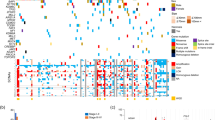Abstract
Previous studies have shown that during the period subsequent to the Chernobyl accident, increases in morbidity, aggressivity and proliferative activity of renal-cell carcinomas (RCCs) in Ukrainian patients were recognized. The present paper describes the molecular alterations of those tumor suppressor genes located on chromosome 9p21 (INK4a/ARF locus and p15INK4B) in 26 primary renal-cell epithelial tumors from patients with different degrees of radiation exposure after the Chernobyl accident in Ukraine. Radiometric measurement of Cesium 137 (137Cs) was conducted with 1-day urine from all patients before surgery. Our results demonstrate that RCCs from patients living in the radio-contaminated areas showed aberrant hypermethylation of p14ARF and p16INK4A genes, associated with increased p38MAPK, p14ARF, mdm2, cyclinD1 and Ki67 protein expression levels. Present findings show the possibility that chronic long-term low-dose radiation activates the INK4a/ARF locus, targeted by activation of the p38MAPK cascade. These actions could lead to disruptions and loss of cell cycle checkpoints and, thereby, to cellular transformation.


Similar content being viewed by others
References
Adler V, Yin Z, Tew KD, Ronai Z (1999) Role of redox potential and reactive oxygen species in stress signaling. Oncogene 18:6104–6111
Bostwick DG, Murphy GP (1998) Diagnosis and prognosis of renal cell carcinoma: highlights from an international consensus workshop. Semin Urol Oncol 16:46–52
Brinda RS, Vasselli JR, Stearman R, Linehan WM, Klauser RD (2002) VH-mediated hypoxia regulation of cyclin D1 in renal carcinoma cells. Cancer Res 62:3014–3019
Carnero A (2000) Cell cycle and cancer, rev. Oncologia 2:12–22
Esteller M, Tartola S, Toyota M, Capella G, Peinado MA, Baylin SB, Herman JG (2000) Hypermethylation—associated inactivation of p14ARF is independent of p16INK4A methylation and p53 mutation status. Cancer Res 60:129–133
Galibert MD, Carreira S, Goding CR (2001) The Usf-1 transcription factor is a novel target for the stress-responsive p38 kinase and mediates UV-induced tyrosinase expression. EMBO J 20:5022–5031
Gillett CE, Barnes DM (1998) Cell cycle. J Clin Pathol 51:310–316
Haitel A, Wiener HG, Baethge U, Marberger M, Susani M (2000) Mdm2 expression as a prognostic indicator in clear cell carcinoma: comparison with p53 overexpression and clinicopathological parameters. Clin Cancer Res 6:1840–1844
Johnson DG, Walker CL (1999) Cyclins and cell cycle checkpoints. Annu Rev Pharmacol Toxicol 39:295–312
Little JB (2000) Radiation carcinogenesis. Carcinogenesis 21:397–404
Lopez-Guerrero JA, Pellin A, Noguera R, Carda C, Llombart-Bosch A (2001) Molecular analysis of the 9q21 locus and p53 gene in Ewing family tumors. Lab Invest 81:803–814
Lundberg AS, Weinberg RA (1999) Control of the cell cycle and apoptosis. Eur J Cancer 35:531–539
Martin JMC, Balkenende A, Verschoor T, Lallemand F, Michalides R (1999) CyclinD1 over-expression enhances radiation-induced apoptosis and radiosensitivity in a breast tumor cell line. Cancer Res 9:1134–1140
Parvey S, Conroy S, Rassell T, Gabrielli B (1999) Ultraviolet radiation induces p16CDKN2a expression in human skin. Cancer Res 59:4185–4189
Prasad AV, Mohan N, Chandrasekar B, Meltz ML (1994) Activation of nuclear factor kB in human lymphoblastoid cells by low-dose ionizing radiation. Radiat Res 138:367–372
Quelle DE, Zindy F, Roussel MF, Quelle DE, Downing JR, Ashmun RA, Grosveld G, Sherr CJ (1997) Tumor suppression at the mouse INK4a locus mediated by the alternative reading frame product p19ARF. Cell 9:649–659
Raes F, De Cort M, Graziani G (1991) Multi-fractal nature of radioactivity deposition on soil after the Chernobyl accident. Health Phys 61:271–282
Richmond CR (1968) Accelerating the turnover of internally deposited radiocesium. In: Kornberg HA, Norwood WD (eds) Diagnosis and treatment of deposited radionuclides. Excerpta Medical Foundation, Richland, WA, pp 315–325
Rocco JW, Sidransky D (2001) p16(MTS-1/CDKN2/INK4a) in cancer progression. Exp Cell Res 264:42–55
Romanenko A, Lee CC, Yamamoto S, Hori TA, Wanibuchi H, Zaparin W, Vinnichenko W, Vozianov A, Fukushima S (1999) Urinary bladder lesions after the Chernobyl accident: immunohistochemical assessment of p53, proliferating cell nuclear antigen, cyclin D1 and p21WAF1/Cip1. Jpn J Cancer Res 90:144–153
Romanenko A, Morell-Quadreny L, Nepomnyaschy V, Vozianov A, Llombart-Bosch A (2000) Pathology and proliferative activity of renal-cell carcinomas (RCCs) and renal oncocytomas in patients with different radiation exposure after the Chernobyl accident in Ukraine. Int J Cancer 87:880–883
Romanenko A, Morell-Quadreny L, Nepomnyaschy V, Vozianov A, Llombart-Bosch A (2001) Radiation sclerosing proliferative atypical nephropathy of peritumoral tissue of renal-cell carcinomas after the Chernobyl accident in Ukraine. Virchows Arch 438:146–153
Sambrook J, Fritsch EF, Maniatis T (1989) Molecular cloning. A laboratory manual. Cold Spring Harbor Laboratory Press, Cold Spring Harbor, pp 1–83
Serrano M (2000) The INK4a/ARF locus in murine tumorigenesis. Carcinogenesis 21:865–869
Sherr CJ, Weber JD (2000) The ARF/p53 pathway. Curr Opin Genet Dev 10:94–99
Suzuki K, Kodama S, Watanabe M (2001) Extremely low-dose ionizing radiation causes activation of mitogen-activated protein kinase pathway and enhances proliferation of normal human diploid cells. Cancer Res 61:5396–5401
Wang X, Martindale IL, Liu Y, Holbrook NJ (1998) The cellular response to oxidative stress: influences of mitogen-activated protein kinase signalling pathways on cell survival. Biochem J 333:291–300
Wu LJ, Randers-Pehrson G, Xu A, Waldren CA, Geard CR, Yu ZL, Hei TK(1999) Targeted cytoplasmic irradiation with alpha particles induces mutations in mammalian cells. Proc Natl Acad Sci U S A 96:4959–4964
Acknowledgements
The authors are grateful to Estela Pons and Alejo Sempere for their technical assistance. Source of support: GV01–532 from the Generalitat Valenciana and FIS 01/0702 from the Ministry of Health, Madrid, Spain.
Author information
Authors and Affiliations
Corresponding author
Rights and permissions
About this article
Cite this article
Romanenko, A., Morell-Quadreny, L., Lopez-Guerrero, J.A. et al. The INK4a/ARF locus: role in cell cycle control for renal cell epithelial tumor growth after the Chernobyl accident. Virchows Arch 445, 298–304 (2004). https://doi.org/10.1007/s00428-004-1056-7
Received:
Accepted:
Published:
Issue Date:
DOI: https://doi.org/10.1007/s00428-004-1056-7




